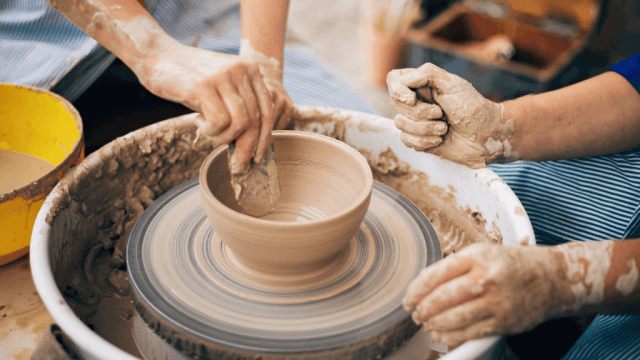Yes, a pottery business can be profitable if one effectively manages production costs, creates unique and high-quality products, targets the right customers, and implements effective marketing strategies.
Success also depends on factors such as location, target market, and demand for handmade or customized pottery items.
Potential Profitability of a Pottery Business
The profitability of a pottery business depends on several factors, including production costs, business model, target customers, and marketing strategies.
By understanding these factors and making smart decisions, running a successful pottery business is possible.
Effective Management of Pottery Costs
Managing pottery costs is essential for turning a profit.
This can be achieved through bulk material purchases, efficient use of resources, streamlining processes, and reducing waste.
Additionally, investing in reliable equipment and carrying out regular maintenance can help prevent costly breakdowns and delays.
Creating High-Quality and Unique Products
Offering unique, high-quality products that cater to your target market’s preferences and needs can set your pottery business apart.
Experimenting with different pottery techniques, glazes, and designs can help develop your distinctive style and reputation, attracting more customers and justifying premium pricing.
Identifying Your Target Market
Understanding your target audience is crucial for any business.
Identify who your potential customers are, such as collectors, interior design enthusiasts, or those who appreciate handmade items.
Focusing your marketing efforts and product offerings toward the preferences and needs of your chosen demographic can lead to more successful sales.
Optimizing Sales Channels
Selecting the most appropriate sales channels for your pottery business can greatly impact profitability.
Online sales platforms, such as Etsy or your own e-commerce website, can provide access to a global audience, while local craft fairs, art shows, or brick-and-mortar shops facilitate direct customer interactions and create a personal connection.
Implementing Effective Marketing Strategies
Well-executed marketing strategies play a significant role in ensuring a profitable pottery business.
Harnessing the power of social media, email marketing, and search engine optimization (SEO) can spread awareness, grow your customer base, and ultimately promote sales.
Collaborating with influencers or featuring your pottery in design magazines or trade shows can also boost your brand’s credibility and reach.
Developing a Business Plan
A clear and comprehensive business plan is key to achieving profitability, as it guides your decision-making process and identifies potential challenges.
Include critical components such as market analysis, product offerings, financial projections, and marketing strategies.
Regular updates and revisions will help you adapt to changing market conditions and ensure long-term success.
Setting Competitive Prices
Competitive pricing is fundamental for a profitable pottery business.
Research local and online competitors, and consider your target market’s budget when establishing a pricing strategy.
Ensure you cover your costs, including raw materials, labor, utilities, equipment, and other overhead expenses while maintaining a healthy profit margin.
Networking and Building Relationships
Establishing strong professional relationships within the pottery and art community can boost your business’s profitability.
Connecting with fellow artists, suppliers, and potential clients can lead to invaluable collaboration opportunities, referrals, and industry insight.
Join trade organizations and attend art fairs, workshops, and networking events to build your professional network.
Investing in Professional Development
Continuously honing your pottery skills and industry knowledge can contribute to your business’s profitability.
Attend workshops, classes, and conferences to learn about advancements in pottery techniques, materials, and tools, as well as effective marketing practices and business management strategies.
Embrace a growth mindset that encourages learning and personal development.
Offering Complementary Products and Services
To increase your profit potential, consider offering complementary products and services beyond pottery items.
For example, sell related merchandise like pottery tools and materials, or provide pottery classes and workshops.
Expanding your line of products or services can broaden your reach, attract new customers, and increase overall revenue.
Frequently Asked Questions
In this FAQ section, we address some common questions related to starting and running a profitable pottery business.
These brief, direct answers highlight key aspects that may be helpful to readers.
What are some ways to reduce pottery costs and improve profitability?
Minimize pottery costs by buying materials in bulk, employing efficient production methods, reducing waste, and investing in reliable equipment.
Maintaining reasonable overhead expenses and adopting energy-efficient practices can also contribute to increased profitability.
How can I differentiate my pottery products from competitors’ offerings?
Develop a distinctive style through experimentation with various pottery techniques, glazes, and designs.
Focus on creating high-quality, unique items that cater to your target market’s preferences and needs, allowing for premium pricing and a competitive edge.
What are some good marketing strategies for a pottery business?
Effective marketing strategies for a pottery business include leveraging social media platforms, email marketing, search engine optimization (SEO), collaborating with influencers, and featuring your products in design magazines or trade shows.
How do I select the right sales channel for my pottery business?
Choose a sales channel based on your target market, geographical reach, and personal preferences.
Online platforms (Etsy, e-commerce websites) enable global access, while local craft fairs, art shows, or brick-and-mortar shops facilitate direct, personal interactions with customers.
How can I ensure long-term profitability while running a pottery business?
Achieve long-term profitability by maintaining a clear, up-to-date business plan, setting competitive prices, investing in professional development, building networking relationships, and offering complementary products or services to expand your revenue streams.











